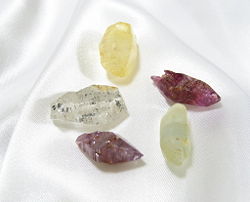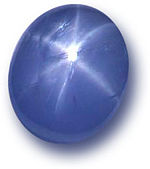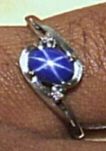Difference between revisions of "Sapphire" - New World Encyclopedia
| Line 34: | Line 34: | ||
}} | }} | ||
| − | A '''sapphire''' (from the [[Latin]] ''sapphirus'' and [[Greek]] ''sappheiros'', perhaps derived from the [[Hebrew language|Hebrew]] word ספּיר, sapir) is a [[gemstone]] belonging to a family of gems that are varieties of the mineral [[corundum]]. Pure corundum is composed of [[aluminum oxide]]* (Al<sub>2</sub>O<sub>3</sub>) and is colorless, but trace amounts of various elements produce a range of colors, such as blue, green, yellow, orange, pink, purple, and red. The term ''sapphire'' is commonly used in referring to the blue variety, but nearly all the colorful gem-quality forms (except red) are classified as sapphires. The red variety is known as [[ruby]]. | + | A '''sapphire''' (from the [[Latin]] ''sapphirus'' and [[Greek]] ''sappheiros'', perhaps derived from the [[Hebrew language|Hebrew]] word ספּיר, sapir) is a [[gemstone]] belonging to a family of gems that are varieties of the mineral [[corundum]]. Pure corundum is composed of [[aluminum oxide]]* (Al<sub>2</sub>O<sub>3</sub>) and is colorless, but trace amounts of various elements (such as [iron]] or [[nickel]]) produce a range of colors, such as blue, green, yellow, orange, pink, purple, and red. The term ''sapphire'' is commonly used in referring to the blue variety, but nearly all the colorful gem-quality forms (except red) are classified as sapphires. The red variety (produced by the presence of [[chromium]]) is known as [[ruby]]. |
==Sapphires in nature== | ==Sapphires in nature== | ||
| Line 44: | Line 44: | ||
=== Blue sapphires === | === Blue sapphires === | ||
| − | [[Titanium]] and [[iron]] inclusions within the aluminum oxide result in various shades of blue sapphires. Some stones are not well saturated and show tones of gray. It is common to bake natural sapphires to | + | [[Titanium]] and [[iron]] inclusions within the aluminum oxide result in various shades of blue sapphires. Some stones are not well saturated and show tones of gray. It is common to bake natural sapphires to enhance their color, luster, and general appearance. This may be done by heating the sapphires to temperatures of up to 1800°C for several hours, or by heating them in an oven with a nitrogen-deficient atmosphere for seven days or more. |
=== Silk === | === Silk === | ||
| − | Upon magnification, a sapphire may be seen to contain white, needle-like structures known as "silk." These needles are inclusions of the mineral [[rutile]]* (titanium dioxide). If the needles are unbroken, it indicates that the stone was not heated. If the silk is not visible, then the stone was heated adequately. If the silk is partially broken, then a process known as low tube heat was used. Low tube heat is a process in which the rough stone is heated to 1300 °C for 20 to 30 minutes over charcoal. This takes out any gray or brown in the stone and improves color saturation. | + | Upon magnification, a sapphire may be seen to contain white, needle-like structures known as "silk." These needles are usually inclusions of the mineral [[rutile]]* (titanium dioxide). If the needles are unbroken, it indicates that the stone was not heated. If the silk is not visible, then the stone was heated adequately. If the silk is partially broken, then a process known as low tube heat was used. Low tube heat is a process in which the rough stone is heated to 1300 °C for 20 to 30 minutes over charcoal. This takes out any gray or brown in the stone and improves color saturation. |
| − | |||
[[Image:Star-Saphire.jpg|right|thumb|150px|Star Sapphire]] | [[Image:Star-Saphire.jpg|right|thumb|150px|Star Sapphire]] | ||
[[Image:Star_sapphire.jpg|thumbnail|239px|A "star sapphire" ring with two [[diamonds]] on a [[silver]] band.]] | [[Image:Star_sapphire.jpg|thumbnail|239px|A "star sapphire" ring with two [[diamonds]] on a [[silver]] band.]] | ||
| − | A '''star sapphire''' is a type of sapphire that exhibits a star-like pattern known as [[asterism (gemmology)|asterism]]*. | + | === Star sapphires === |
| + | |||
| + | A '''star sapphire''' is a type of sapphire that exhibits a star-like pattern known as "[[asterism (gemmology)|asterism]]*." The silk within the sapphire is arranged in a manner that produces a six-rayed or twelve-rayed star, when viewed with a single overhead light source. (Twelve-rayed stars are less common.) | ||
The value of a star sapphire depends not only on the [[carat]]* weight of the stone but also the body color, visibility, and intensity of the star. Some sapphires are heat-treated or otherwise enhanced to improve their appearance and color, though some people object to such practices and prefer natural, untreated stones. Treated stones tend to be darker than untreated ones, and the treatment process causes changes to the internal structure that are generally easily detected. | The value of a star sapphire depends not only on the [[carat]]* weight of the stone but also the body color, visibility, and intensity of the star. Some sapphires are heat-treated or otherwise enhanced to improve their appearance and color, though some people object to such practices and prefer natural, untreated stones. Treated stones tend to be darker than untreated ones, and the treatment process causes changes to the internal structure that are generally easily detected. | ||
| Line 99: | Line 100: | ||
* [[Gemstone]] | * [[Gemstone]] | ||
| + | * [[Mineral]] | ||
* [[Ruby]] | * [[Ruby]] | ||
Revision as of 02:52, 10 January 2007
| Sapphire | |
|---|---|
 |
|
| General | |
| Category | Mineral |
| Chemical formula | aluminum oxide, Al2O3 |
| Identification | |
| Color | Blue, pink, yellow, green, white, and parti-colour |
| Crystal habit | massive and granular |
| Crystal system | Trigonal |
| Cleavage | None |
| Fracture | Conchoidal, splintery |
| Mohs Scale hardness | 9.0 |
| Luster | Vitreous |
| Refractive index | 1.762-1.778 |
| Pleochroism | Strong |
| Streak | White |
| Specific gravity | 3.95-4.03 |
| Fusibility | infusible |
| Solubility | insoluble |
| Major varieties | |
| Ruby | When contaminated with chromium |
A sapphire (from the Latin sapphirus and Greek sappheiros, perhaps derived from the Hebrew word ספּיר, sapir) is a gemstone belonging to a family of gems that are varieties of the mineral corundum. Pure corundum is composed of aluminum oxide (Al2O3) and is colorless, but trace amounts of various elements (such as [iron]] or nickel) produce a range of colors, such as blue, green, yellow, orange, pink, purple, and red. The term sapphire is commonly used in referring to the blue variety, but nearly all the colorful gem-quality forms (except red) are classified as sapphires. The red variety (produced by the presence of chromium) is known as ruby.
Sapphires in nature
Occurrence
Sapphires are mined from alluvial deposits or from primary underground workings. Historically, most sapphires have been mined in Sri Lanka, Madagascar, and Myanmar. Australia leads the world in sapphire production (as of 1987), specifically from basalt-derived placer deposits in Queensland and New South Wales. Pakistan, Afghanistan, India, Tanzania and Kenya also produce sapphires. In the United States, the state of Montana has produced sapphires from the Yogo Gulch deposit near Helena. Gem-grade sapphires and rubies are also found in and around Franklin, North Carolina. Several mines are open to the public.
Blue sapphires
Titanium and iron inclusions within the aluminum oxide result in various shades of blue sapphires. Some stones are not well saturated and show tones of gray. It is common to bake natural sapphires to enhance their color, luster, and general appearance. This may be done by heating the sapphires to temperatures of up to 1800°C for several hours, or by heating them in an oven with a nitrogen-deficient atmosphere for seven days or more.
Silk
Upon magnification, a sapphire may be seen to contain white, needle-like structures known as "silk." These needles are usually inclusions of the mineral rutile (titanium dioxide). If the needles are unbroken, it indicates that the stone was not heated. If the silk is not visible, then the stone was heated adequately. If the silk is partially broken, then a process known as low tube heat was used. Low tube heat is a process in which the rough stone is heated to 1300 °C for 20 to 30 minutes over charcoal. This takes out any gray or brown in the stone and improves color saturation.
Star sapphires
A star sapphire is a type of sapphire that exhibits a star-like pattern known as "asterism." The silk within the sapphire is arranged in a manner that produces a six-rayed or twelve-rayed star, when viewed with a single overhead light source. (Twelve-rayed stars are less common.)
The value of a star sapphire depends not only on the carat weight of the stone but also the body color, visibility, and intensity of the star. Some sapphires are heat-treated or otherwise enhanced to improve their appearance and color, though some people object to such practices and prefer natural, untreated stones. Treated stones tend to be darker than untreated ones, and the treatment process causes changes to the internal structure that are generally easily detected.
Fancy sapphires
Sapphires that are not blue are referred to as "fancy sapphires." Purple sapphires, lower in price than blue ones, contain the trace element vanadium and come in a variety of shades. Yellow and green sapphires have traces of iron, which gives them their color. Pink sapphires have traces of chromium; the deeper the pink, the higher the value of the stone, as long as the color goes toward the red of rubies. Some "color-shift" sapphires are blue in outdoor light and purple in indoor lighting. Other stones may shift color from pink in daylight to greenish in fluorescent light. Some stones shift color well; others, only partially. White sapphires usually come out of the ground as light gray or brown and are then heated to make them clear; but in rare circumstances, they are found in a clear state.
Synthetic sapphires for non-gemstone applications
Sapphires can be manufactured in large crystal boules for a variety of applications.
Synthetic sapphire crystals can be grown in cylindrical crystal ingots of large size, up to many inches in diameter. As well as gemstone applications there are many other uses:
The first ever laser produced was based on the ruby chromium impurity in sapphire. While this laser has few applications, the Ti-sapphire laser is popular due to the relatively rare ability to tune the laser wavelength in the red-to-near infrared region of the electromagnetic spectrum. It can also be easily modelocked. In these lasers, a synthetically produced sapphire crystal with chromium or titanium impurities is irradiated with intense light from a special lamp, or another laser, to create stimulated emission.
Pure sapphire ingots can be sliced into wafers and polished to form transparent crystal slices. Such slices are used as watch faces in high quality watches, as the material's exceptional hardness makes the face almost impossible to scratch. Since sapphire ranks a 9 on the Mohs scale, owners of such watches should still be careful to avoid exposure to diamond jewelry, and should avoid striking their watches against artificial stone and simulated stone surfaces. Such surfaces often contain materials including silicon carbide, which, like diamond, are harder than sapphire and thus capable of causing scratches (Scheel 2003).
Wafers of single crystal sapphire are also used in the semiconductor industry as a substrate for the growth of gallium nitride based devices.
Historical and cultural views
- According to Rebbenu Bachya, the word "Sapir" in the verse Exodus 28:20 means "Sapphire" and was the stone on the Ephod representing the tribe of Issachar. This interpretation, however, is disputed, as the biblical "sapphire" has been equated with lapis lazuli (Texas Natural Science Center, 2006).
- Supernatural powers were attributed to gems in India. One way this was manifested was the interdependence between gems and planets. Ruby, associated with the Sun, was the Lord of Gems, for the Sun lorded over all the planets. Blue sapphire is associated with Saturn (Wojtilla, 1973), and yellow sapphire, with Jupiter.
- Blue sapphires were first discovered in the Padar region of Kashmir in the 1880s, allegedly where a landslip had uncovered their occurrence. Kashmir stones were in most cases exceptionally fine quality. Stones from Madagascar are often described as resembling Kashmir quality.
- Sapphire is the birthstone associated with September.
- The 45th wedding anniversary is known as the sapphire anniversary.
Some famous sapphires
- The Logan Sapphire
- The Queen Marie of Romania Sapphire
- The Ruspoli Sapphire
- The Star of Asia Star Sapphire
- The Star of Bombay (given to Mary Pickford by Douglas Fairbanks, Sr.)
- The Star of India (the world's largest and most famous star sapphire)
- The Stuart Sapphire
See also
ReferencesISBN links support NWE through referral fees
- Scheel, Hans J. and Tsuguo Fukuda (Eds) (2003). Crystal Growth Technology, John Wiley & Sons. ISBN 0-471-49059-8. (Available as PDF
- Sofianides, Anna S. and George E. Harlow (1997). Gems & Crystals. Parkgate Books, pp. 44-55 ISBN 1-85585-391-4.
- Texas Natural Science Center, Mineral Lore and Mythology, 2006.
- Mindat with location data
- Wojtilla, G. Indian precious stones in the ancient East and West, Acta Orientakia (Budapest) 27, 2, 211-224.
- Sethi, Parvinder S. "Nature’s Perfect Imperfections", The World & I, Dec. 1997, p. 186.
- Weinstein, Michael (1958). The World of Jewel Stones. New York: Sheridan House.
Credits
New World Encyclopedia writers and editors rewrote and completed the Wikipedia article in accordance with New World Encyclopedia standards. This article abides by terms of the Creative Commons CC-by-sa 3.0 License (CC-by-sa), which may be used and disseminated with proper attribution. Credit is due under the terms of this license that can reference both the New World Encyclopedia contributors and the selfless volunteer contributors of the Wikimedia Foundation. To cite this article click here for a list of acceptable citing formats.The history of earlier contributions by wikipedians is accessible to researchers here:
The history of this article since it was imported to New World Encyclopedia:
Note: Some restrictions may apply to use of individual images which are separately licensed.

